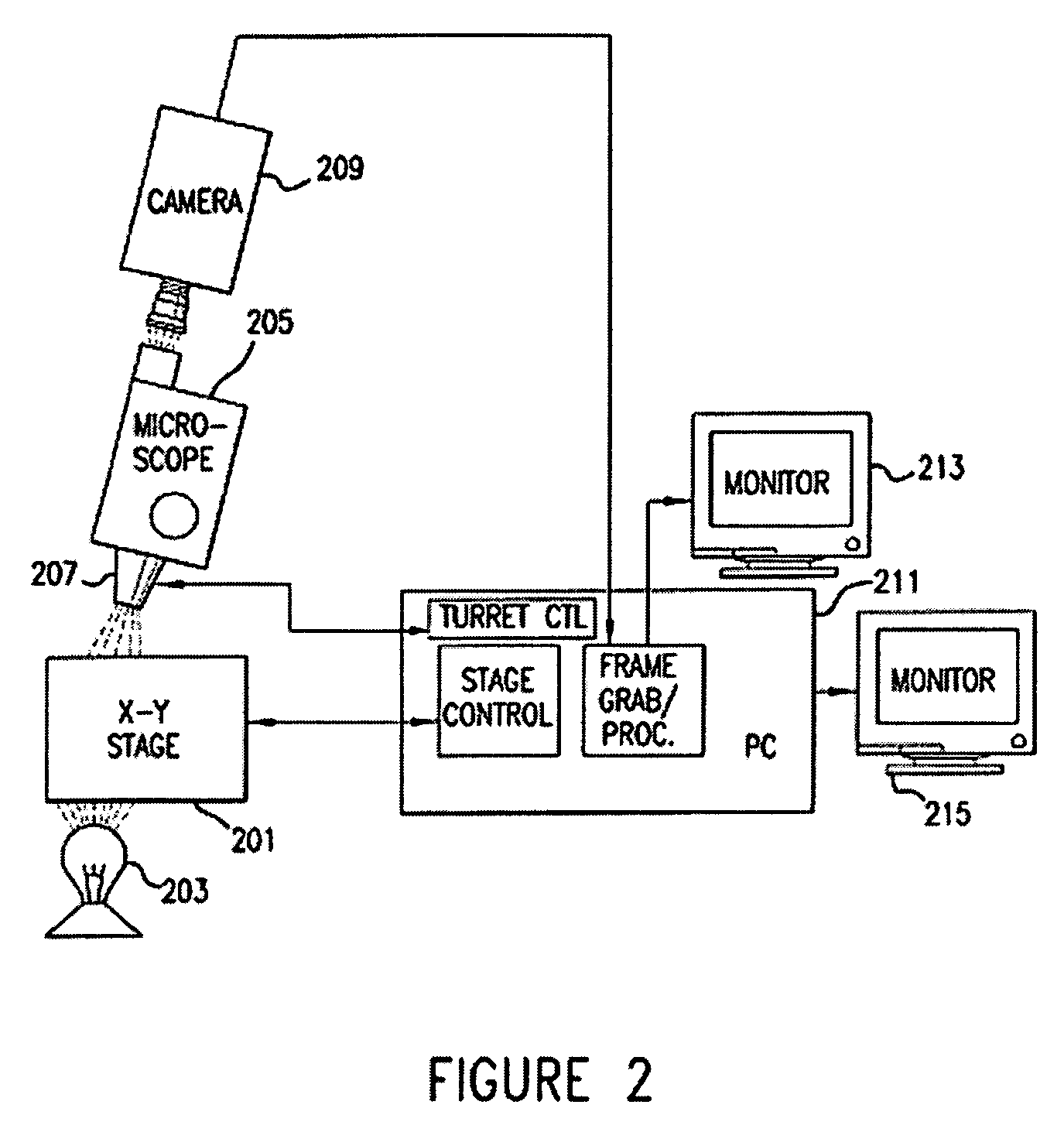[0011] The method further comprises contacting a body fluid or tissue sample at a location corresponding to each candidate blob represented in the subset of the first image data set, with a reagent to generate a medically significant signal. This method provides the advantage of being able to remove from further processing a body fluid or tissue sample for which no subset of the first data set representing a candidate blob is created. The signal can be measured to determine whether it is a significant signal level. The first and / or the second image data subsets can be transformed into a representation that is more suitable for control and processing by a computer as described herein. In a preferred embodiment, the image data is transformed from an RGB (Red Green Blue) signal into an HLS (Hue Luminescence Saturation) signal. Filters and / or masks are utilized to distinguish those cells that meet pre-selected criteria and eliminate those that do not, and thus identify rare cells.
[0014] In general, a subset of a first image data set can be created as described above. The steps further encompass contacting a body fluid or tissue sample at a location corresponding to each candidate blob represented in the subset of the first image data set, with a reagent to generate a medically significant signal. This provides the advantage of being able to remove from further processing a body fluid or tissue sample for which no subset of the first data set representing a candidate blob is created. There is an optional step by which the signal can be measured to determine whether it is of a significant level. Another optional step encompasses transformation of one or both of the first and the second image data subsets into a representation that is more suitable for control and processing by a computer as described herein. In a preferred embodiment, the image data is transformed from an RGB (Red Green Blue) signal into an HLS (Hue Luminescence Saturation) signal. Filters and / or masks are utilized to distinguish those cells that meet pre-selected criteria and eliminate those that do not.
[0030] According to yet another aspect of the invention, there is provided a device for screening fetal cells contained within a smear of an unenriched sample of maternal blood containing a naturally present concentration of fetal cells, comprising: a flexible film having thereon a smear of at least 250% of maternal blood. In one embodiment, the flexible film has thereon a smear of at least 500 μl of maternal blood. In one important embodiment, the flexible film is an elongated film, the length being at least 10 times the width. It is particularly preferred that the flexible film include marking coordinates, whereby the computerized microscopic vision system described herein can locate a cell relative to a point on the film, permitting that cell to be returned to at a later time, if desired.
[0031] According to yet another aspect of the invention, there is provided a device for screening rare cells contained within a sample of cells at a concentration of no greater than one rare cell for every 10,000 cells in the sample of cells. The device is a flexible film having fixed thereon the sample of cells, wherein the flexible film is at least five inches long. In one preferred embodiment the flexible film has a length at least 10 times its width. In another important embodiment, the flexible film includes marking coordinates, whereby the computerized microscopic vision system described herein can locate a cell relative to a point on the film, permitting the cell to be returned to at a later time, if desired.
[0033] According to another important embodiment of the invention, the need for scanning large areas of microscopic preparations in the minimum possible amount of time is met by the use of an apparatus or system that provides a “composed” image. It is based on the simultaneous use of an array of computer controlled objective lenses, arranged on a support system and having the capacity to focus on a microscopic preparation. Each of the objective lenses is connected to a charge coupled device camera, herein referred to as a CCD camera, being connected to image acquisition hardware installed in a host computer. The images are stored in the computer memory and they are combined in an appropriate side to side fashion, so that a “composed” image is formed in the computer memory. The “composed” image can be further processed as a unity, using any kind of imaging procedures to detect specific features that are in question. The significant advantage of the described system consists in its capacity to acquire images simultaneously from a number of objective lenses, thus minimizing the time needed to process large areas of the sample in a manner that is inversely proportional to the number of objectives used.
 Login to View More
Login to View More 


